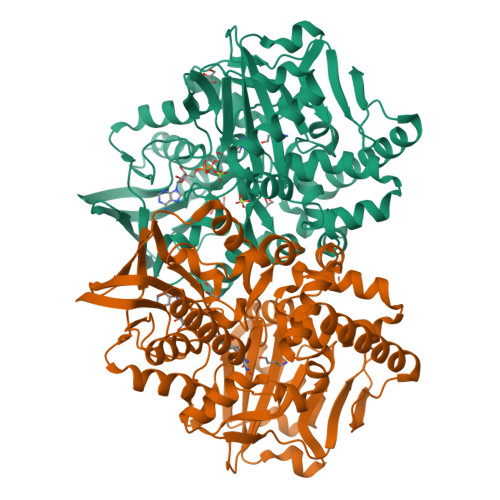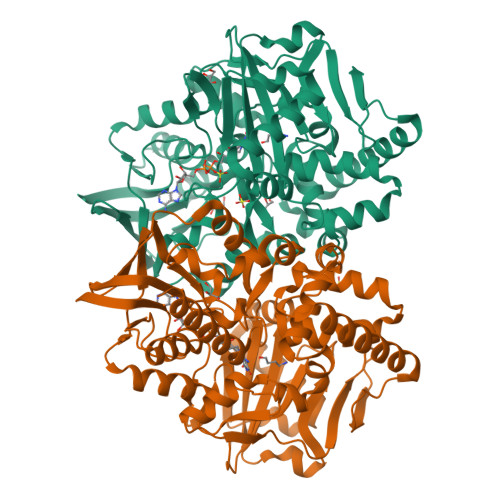Structure-Based Redesign of Cofactor Binding in Putrescine Oxidase.
Kopacz, M.M., Rovida, S., Van Duijn, E., Fraaije, M.W., Mattevi, A.(2011) Biochemistry 50: 4209
- PubMed: 21486042
- DOI: https://doi.org/10.1021/bi200372u
- Primary Citation of Related Structures:
2YG3, 2YG4, 2YG5, 2YG6, 2YG7 - PubMed Abstract:
Putrescine oxidase (PuO) from Rhodococcus erythropolis is a soluble homodimeric flavoprotein, which oxidizes small aliphatic diamines. In this study, we report the crystal structures and cofactor binding properties of wild-type and mutant enzymes. From a structural viewpoint, PuO closely resembles the sequence-related human monoamine oxidases A and B. This similarity is striking in the flavin-binding site even if PuO does not covalently bind the cofactor as do the monoamine oxidases. A remarkable conserved feature is the cis peptide conformation of the Tyr residue whose conformation is important for substrate recognition in the active site cavity. The structure of PuO in complex with the reaction product reveals that Glu324 is crucial in recognizing the terminal amino group of the diamine substrate and explains the narrow substrate specificity of the enzyme. The structural analysis also provides clues for identification of residues that are responsible for the competitive binding of ADP versus FAD (~50% of wild-type PuO monomers isolated are occupied by ADP instead of FAD). By replacing Pro15, which is part of the dinucleotide-binding domain, enzyme preparations were obtained that are almost 100% in the FAD-bound form. Furthermore, mutants have been designed and prepared that form a covalent 8α-S-cysteinyl-FAD linkage. These data provide new insights into the molecular basis for substrate recognition in amine oxidases and demonstrate that engineering of flavoenzymes to introduce covalent linkage with the cofactor is a possible route to develop more stable protein molecules, better suited for biocatalytic purposes.
Organizational Affiliation:
Laboratory of Biochemistry, Groningen Biomolecular Sciences and Biotechnology Institute, University of Groningen, Nijenborgh 4, 9747 AG Groningen, The Netherlands.






















